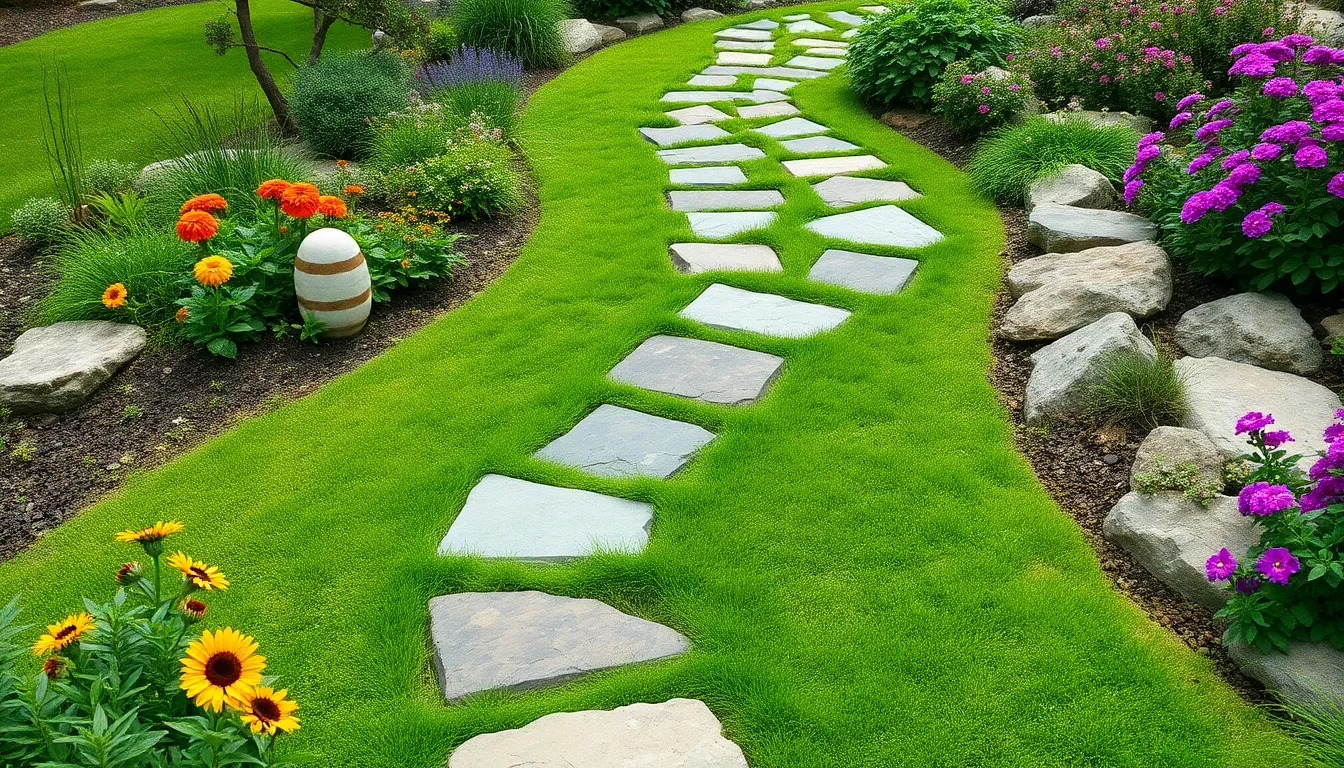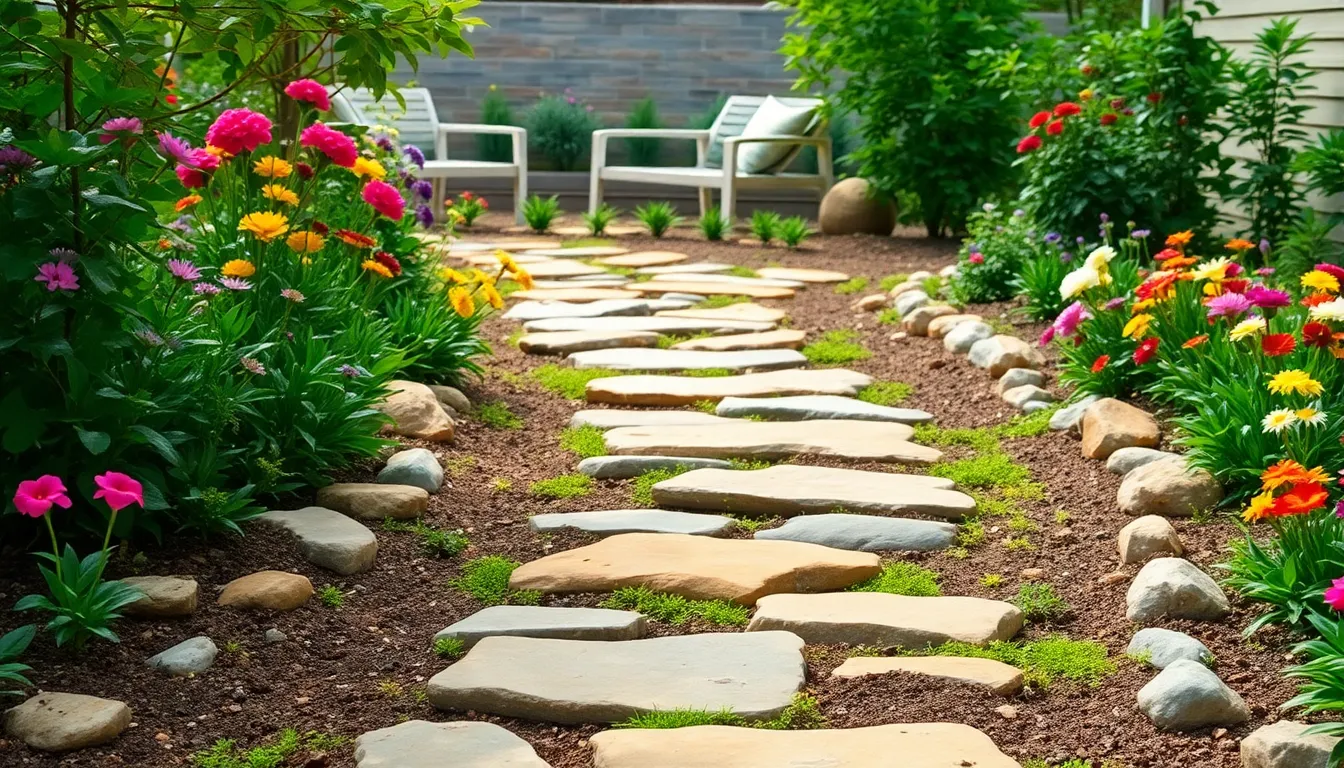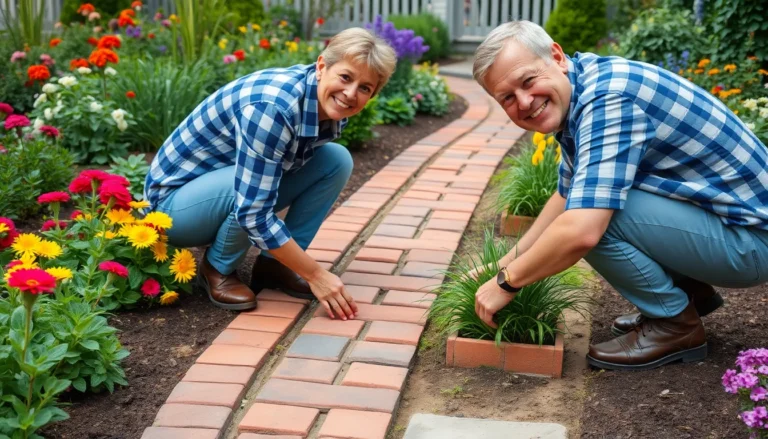Transforming an ordinary garden into a stunning oasis can feel like a daunting task. But fear not! Landscaping stepping stones are the unsung heroes of outdoor design, paving the way to a more enchanting space. These charming stones not only guide the way through lush greenery but also add a touch of whimsy that even your garden gnomes would approve of.
Imagine strolling through your yard, stepping on perfectly placed stones that lead you to hidden treasures like blooming flowers or a cozy seating area. With endless styles and materials to choose from, stepping stones can elevate your landscape from “meh” to “wow!” So grab your gardening gloves and get ready to create a pathway that’ll make your neighbors green with envy. After all, who wouldn’t want a little magic beneath their feet?
Landscaping Stepping Stones
Landscaping stepping stones play a crucial role in garden design, providing both aesthetic appeal and practical function. Homeowners use these stones to create paths that guide visitors through gardens, snow, or gravel, ensuring easy navigation. Materials for stepping stones vary widely, including natural stone, concrete, and recycled materials, catering to diverse design preferences.
Design options for stepping stones also include an array of shapes and sizes, from circular to square, allowing customization of pathways. Colors range from earthy tones to bright hues, enabling alignment with existing garden themes. Each choice contributes uniquely to the overall look and feel of the outdoor space.
Placement strategies significantly impact the effectiveness of stepping stones. Consider a staggered layout to encourage a natural flow through the garden, inviting exploration. Ensuring proper spacing between stones enhances accessibility, facilitating movement for foot traffic or gardening activities.
Additionally, integration with surrounding elements enhances visual impact. Pairing stepping stones with ground covers like moss or gravel creates attractive contrast. Incorporating low-growing plants alongside stones softens edges and fosters a harmonious connection with nature.
Homeowners seeking a durable solution should prioritize materials resistant to weather conditions. Options like natural stone provide longevity and withstand the elements, maintaining their beauty over time. Understanding installation techniques also contributes to longevity; proper leveling and drainage prevent sinking or shifting.
Landscaping stepping stones transform any outdoor area into a welcoming retreat. By combining functionality and beauty, these stones elevate landscaping, crafting pathways that inspire admiration and enjoyment.
Types of Landscaping Stepping Stones

Landscaping stepping stones come in various types, each offering unique benefits and visual appeal. Homeowners can choose materials based on style, durability, and the overall design of their gardens.
Natural Stone Options
Natural stone options provide timeless elegance and blend effortlessly with outdoor environments. Flagstone, slate, and limestone serve as popular choices, each offering distinct colors and textures. Flagstone features irregular shapes, creating a more organic pathway. Slate presents a sophisticated, smooth surface, ideal for modern designs. Limestone’s warm tones complement traditional gardens beautifully. Natural stone withstands weather elements, ensuring longevity and durability, making it a reliable investment for landscaping projects.
Concrete Stepping Stones
Concrete stepping stones offer versatility and are customizable to suit individual preferences. Available in various shapes and colors, they can mimic the appearance of natural stone while remaining budget-friendly. Homeowners can explore stamped or textured concrete options, which enhance visual interest. Standard square or rectangular shapes provide a classic look, while circular stones add a playful touch. Additionally, concrete’s resilience against decay makes it an excellent choice for high-traffic areas, ensuring pathways remain functional over time.
Benefits of Using Landscaping Stepping Stones
Landscaping stepping stones offer numerous benefits that enhance outdoor spaces. These stones significantly contribute to both garden aesthetics and functionality.
Aesthetic Appeal
Visual interest comes from varying shapes, sizes, and colors of stepping stones. Earthy tones complement garden foliage while bright hues add vibrancy. Natural stones like flagstone and slate provide a rustic charm. Concrete stones offer modern versatility with customizable patterns. The integration of stepping stones creates walking paths that guide visitors and showcase garden features. Charming arrangements encourage individuals to explore various areas, making gardens inviting.
Functional Advantages
Stepping stones serve practical purposes in landscaping. They create stable walking surfaces, reducing wear on grass or soil. These pathways ensure accessibility during wet conditions, preventing muddy footprints. Stones placed strategically help define garden spaces, enhancing organization without the need for permanent structures. Properly positioned stones invite comfortable navigation while minimizing the risk of tripping. Durable materials withstand weather impacts, ensuring lasting functionality. Options like recycled concrete also support sustainable landscaping choices.
Installation Process for Landscaping Stepping Stones
The installation process for landscaping stepping stones involves careful preparation and execution to ensure durability and aesthetic appeal.
Preparing the Site
Clear the area where stepping stones will sit. Remove grass, weeds, and debris to create a clean foundation. Dig a trench about four inches deep, ensuring space for the stone thickness and gravel base. Next, level the surface using a rake for an even installation. Pour gravel into the trench for drainage, spreading it evenly. This preparation prevents shifting over time and promotes stability. The site should allow for water flow away from stepping stones to reduce pooling.
Laying the Stepping Stones
Start by placing the first stone in the desired location. Ensure adequate distance between stones for foot traffic; typically, this is 2 to 3 feet apart for comfortable navigation. Align the stones in a staggered pattern for a natural look. Tap each stone down firmly to secure it in place. For added stability, fill gaps with soil or gravel, compacting as necessary. Level the stones as needed to prevent uneven surfaces, promoting safe walking paths. Adjust the layout based on personal preference, while considering surrounding elements for a cohesive design.
Maintenance Tips for Landscaping Stepping Stones
Regular maintenance keeps landscaping stepping stones looking their best. Cleaning stones periodically prevents dirt and algae build-up. A soft brush or mild detergent can help remove stubborn stains. Rinsing them with water afterward maintains their shine.
Inspecting the stones for cracks or shifting is important. Addressing these issues promptly prevents further damage and ensures safety. Filling gaps with soil or sand stabilizes them and helps prevent weed growth. Check for uneven surfaces as well; leveling stones promotes safe walking paths.
Mulching around stepping stones reduces weed growth while enhancing aesthetics. Organic mulch, like bark or wood chips, provides a natural look and decomposes over time, enriching soil. Replenishing the mulch as needed ensures long-lasting beauty and functionality.
Seasonal adjustments may also prove beneficial. In colder months, applying de-icer products designed for stone surfaces protects against freeze-thaw cycles. During warmer months, shading stones with plants or decorative features can minimize heat absorption, preventing cracking.
Maintaining proper drainage prevents standing water around stones. Ensuring that surrounding soil directs water away from pathways aids in durability. Gutters and downspouts should also be clear of debris to prevent flooding.
Routine care enhances not just the appearance but also the lifespan of landscaping stepping stones. Establishing a maintenance schedule ensures these features continue to guide visitors through gardens beautifully. Simple tasks like these create a lasting impression in outdoor spaces.
Conclusion
Landscaping stepping stones offer a unique blend of beauty and practicality that can elevate any garden space. By selecting the right materials and designs homeowners can create inviting pathways that enhance their outdoor aesthetics. These stones not only guide foot traffic but also contribute to a harmonious landscape.
With careful planning and proper installation techniques stepping stones can stand the test of time while providing a safe walking surface. Regular maintenance ensures they remain a stunning feature in the garden. Embracing the versatility of stepping stones opens up endless possibilities for transforming outdoor areas into enchanting retreats that reflect personal style and creativity.




